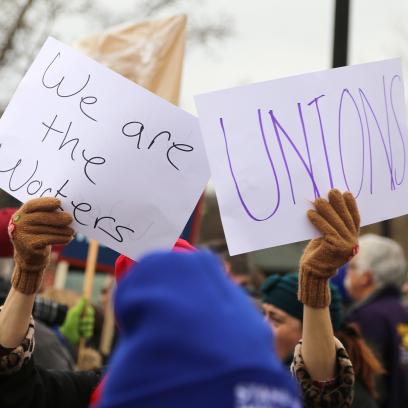Schemes to undercut public sector unions—epitomized by last year’s U.S. Supreme Court decision in Janus v. AFSCME—have stalled, according to new data from the federal Bureau of Labor Statistics.
Despite a billionaire-funded, interminable war on public sector workers’ right to join a union, public service union membership has held strong at 7.17 million, roughly half of the 14.7 million total union members in the United States. Public service unions have seen more joins than drops since the Janus decision last June.
Since then, Janus funders have poured millions into deceptive campaigns urging public service workers to quit their unions. But courts are increasingly siding with employees. The facts and public opinion have always been on our side.
“It’s heartening that working people have seen straight through these right-wing groups’ brazen attempts to destroy our union and other public sector unions,” says AFT President Randi Weingarten. “In fact, our union is growing. Since Janus, we’ve had 11 organizing wins. Union members have sent a clear message: We are sticking with the union.”
Indeed, the AFT has welcomed 88,500 new members in a surge of organizing wins. Other public sector unions also have seen increases in membership. “It was a wake-up call to everyone,” Weingarten says. “Everybody got engaged.”
When faculty at the Old Town School of Folk Music in Chicago joined the Illinois Federation of Teachers this month, they invoked powerful union traditions by singing iconic labor songs like Woody Guthrie’s “Union Maid.” And there are 562 new AFT members in Texas, now that teachers and paraprofessionals at the Pharr-San Juan-Alamo Independent School District voted to affiliate with the AFT.
Among a wave of newly unionized charter schools, the staff at Pittsburgh’s Environmental Charter School voted to join the AFT and Chicago Teachers Union members at Acero (formerly UNO) charter schools took it further, braving four frigid days on the picket line—the first strike ever at a U.S. charter school network—to win pay equity with Chicago Public Schools teachers and paraprofessionals, reduced class sizes, sanctuary school protections and a career path for paraprofessionals.
AFT member Holly Kimpon, a high school teacher and president of the Genoa Area Education Association in Ohio, says Janus-style attacks have achieved nothing. “It’s no different now than it was when the Janus ruling came out,” she says. “The teachers in our district will stick together and stick with our union to make sure we have a say in the future of our kids. I come from a rural and conservative part of Ohio, and all but one of our teachers are dues-paying members. Not one has left the union. In fact, all six new staff members hired this year joined the union. Why? Because we know that our ability to create a safe learning environment for our students and make teaching a viable profession comes directly from being part of a strong union.”
Weingarten says professionals are joining unions because they see them as paths to a better life for everyone. Los Angeles teachers scored a victory for their students this month, using a six-day strike to win reasonable class sizes and adequate staffing. The #RedForEd movement to restore public school funding to pre-recession levels is advancing state by state, with Virginia educators among the latest to join the surge.
Union power comes at the bargaining table and the ballot box, too. The bargaining team for United Teachers of Dade in Florida won their largest raise in history in December after members educated voters about severe shortfalls in education funding. More than 70 percent of Miami-Dade voters approved a ballot measure that increases property taxes to pay for salaries and school safety.
Today, union momentum is the highest it’s been in 15 years, observes Lee Saunders, president of the American Federation of State, County and Municipal Employees. After Janus, “I got a letter telling me that I didn’t have to pay fair share fees anymore,” says Todd Bennington, an AFSCME member in Minnesota. “That’s when I became a member. I believe in the power of collective action.”
Other signs suggest that union power is rising. According to Bloomberg Law, the general counsel for the Republican-controlled National Labor Relations Board has been trying to get around the First Amendment to exterminate Scabby the Rat, a giant inflatable rodent named after workers who cross picket lines. Although labor protests are legally protected, the NLRB wants to ban inflatables and backed an injunction against Scabby in an Illinois federal case, arguing that the rat’s presence is “coercive.”
Lousy employers do hate Scabby. Besides signaling trouble in the workplace, the rat looms over crowds, up to 30 feet tall, with red eyes, sharp teeth and a festering belly. Scabby trolls bad bosses and calls out injustices. The rodent “has a venerable history in the labor movement,” Seattle University law professor Charlotte Garden told Bloomberg. “You can see it from far away, and one thing you’ll know when you see Scabby the Rat is there’s a labor dispute here.”
Now that is union power.
[Annette Licitra]



